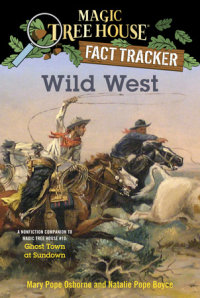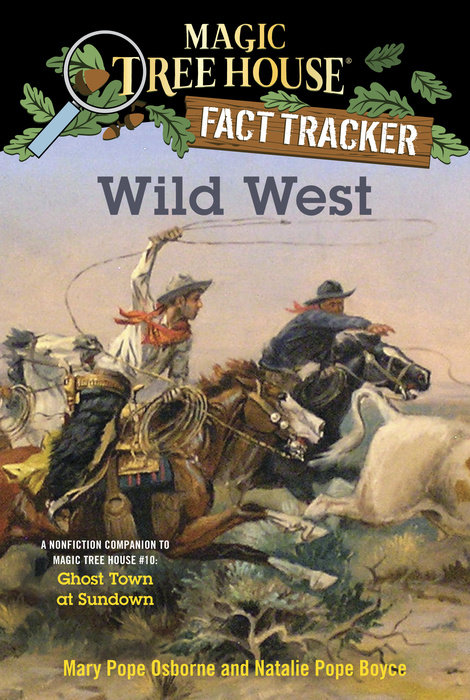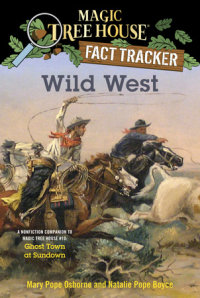Wild West
Wild West is a part of the Magic Tree House Fact Tracker A Stepping Stone Book ™ collections.
Track the facts about cowboys, ghost towns, outlaws, and more!
When Jack and Annie came back from their adventure in Magic Tree House #10: Ghost Town at Sundown, they had lots of questions. What is a ghost town? Why do we call the Old West wild? What are cowboys? Who was Billy the Kid? Find out the answers to these questions and more as Jack and Annie track the facts about the American West.
Filled with up-to-date information, photographs, illustrations, and fun tidbits from Jack and Annie, the Magic Tree House Fact Trackers are the perfect way for kids to find out more about the topics they discover in their favorite Magic Tree House adventures.
Did you know that there's a Magic Tree House book for every kid?
Magic Tree House: Adventures with Jack and Annie, perfect for readers who are just beginning chapter books
Merlin Missions: More challenging adventures for the experienced reader
Super Edition: A longer and more dangerous adventure
Fact Trackers: Nonfiction companions to your favorite Magic Tree House adventures
Have more fun with Jack and Annie at MagicTreeHouse.com!
An Excerpt fromWild West
The Wild West was an amazing time in American history. It began when people settled the American West about 150 years ago. Cowboys, Native Americans, soldiers, outlaws, lawmen, and pioneers who went west in covered wagons all played a part in this exciting story.
The Wild West got its name because sometimes it really was wild. When people first began moving there, it was a wilderness with few sheriffs, judges, or courts, and not even many laws. The Wild West lasted from 1865 to 1895, but the history of the American West began long before that.
In the 1600s and 1700s, thousands of people left Europe to settle in America. Almost all of them lived on the East Coast, along the Atlantic Ocean. When the United States became a country, all thirteen of its states were in the East.
As more and more people came to America, the East got crowded. The U.S. government began thinking about all the empty land in the West. But that land wasn’t really empty. For thousands of years, Native Americans had lived there.
The lands west of the states were called territories of the United States.
A territory (TARE-uh-tor-ee) is an area that the government controls.
When people started moving west, they had a big problem. The trip meant crossing the rugged Appalachian Mountains. The Appalachians stretch from eastern Canada almost 2,000 miles down to the southern United States.
In 1775, the hunter and explorer Daniel Boone led pioneers through a gap in the mountains that became known as the Cumberland Gap. The opening was large enough for horses and wagons to pass through. Then they could travel farther west.
Daniel and his men marked out a 200-mile trail that had been used by Native Americans. It was called the Wilderness Road and went from Virginia to Kentucky. In the 1770s, thousands traveled the road through the Appalachian Mountains into Kentucky and lands farther west.
Mountain Men
By about 1810, trappers and fur traders called mountain men started going as far west as the Rocky and Sierra Nevada Mountains. They worked for fur companies trapping beavers and other animals.
Most mountain men traveled on a trail known as the Oregon Trail. It covered 2,000 miles from Missouri to Oregon. Many pioneers later took this trail, and some went all the way to the West Coast.
Like most Native Americans at the time, mountain men often wore clothes and moccasins made from deerskin. They carried survival gear such as large knives, tomahawks, powder horns, pistols, and rifles. For shelter, the men lived in rough cabins, canvas tents, or tipis. Tipis are cone-shaped tents covered in animal hides. Native Americans on the Great Plains used them.
The men often camped out, even in winter. For food, they hunted deer, buffalo, elk, and bear. Sometimes they ate berries or wild plants, but mostly they ate lots and lots of meat.
Native people sometimes invited the men to stay in their villages. But many native people wanted these strangers off their lands. They weren’t afraid to attack if they thought their way of life was in danger.
Jedediah Strong Smith
Mountain men were tough and brave. One of the toughest was Jedediah Strong Smith. Once, a grizzly bear attacked Jedediah, breaking his ribs and almost tearing his scalp and ear off. Jedediah talked a friend into sewing his ear and scalp back on. After that, he wore his hair long to hide the scars.
Gold!
In 1848, a worker was building a saw-mill called Sutter’s Mill on a river in California. Suddenly, something shiny in the stream caught his eye. It was flakes of gold!
News spread that the California hills were full of gold. In 1849, thousands of men headed to California to get rich. Most of them arrived in ships that sailed around South America. They came from the eastern United States and as far away as China!
Some made their way over rough, rocky trails like the Oregon Trail. The California gold rush ended in the 1850s, but miners kept coming. There was a lot more gold—and silver—in Nevada and Colorado!
Towns grew up around the mining camps. Some of them became big cities that still exist. Others became empty shells after the mines closed. These are called ghost towns.
America Gets Bigger
As more people moved west, more territories became states. By the 1850s, Texas, California, and Oregon had become some of the first western states. But the West covered half the United States, and there was still a lot of land for farms and towns.
The U.S. government wanted to make the country larger by settling these lands. To get people there, President Abraham Lincoln signed the Homestead Act in 1862. It gave 160 acres of western land to people who paid ten dollars and agreed to farm it for five years.
Families by the thousands loaded up their wagons and headed west. Among the new arrivals were outlaws, lawmen, gam- blers, ranchers, shopkeepers, and farmers. The Wild West had begun!


